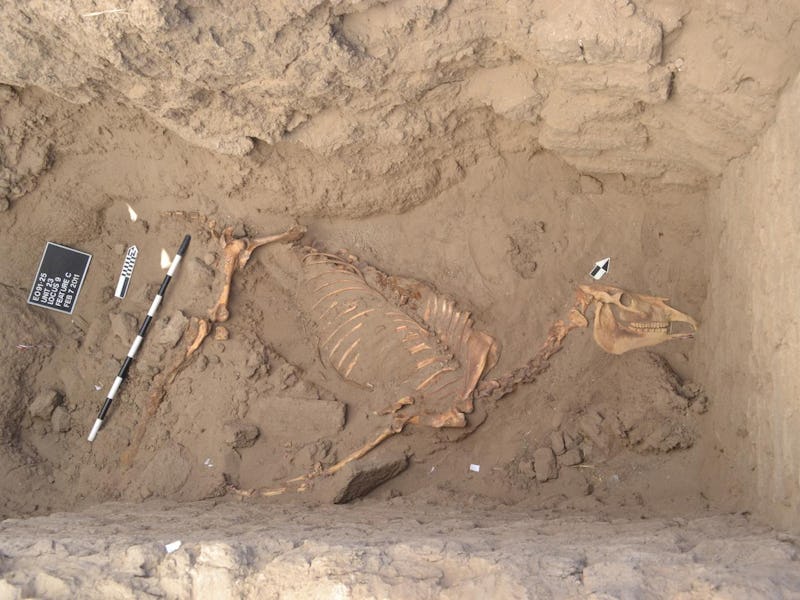Ancient Entombed Horse Was So Well Loved It Still Has Hair on Its Legs
This 3,000-year-old mare is evidence of a big cultural shift.

When archaeologists began excavating the tomb inside a pyramid along the Nile in 2011, they assumed they would find the remains of a human. What they found was even more interesting: the final resting place of a nearly 3,000-year-old horse that was so well-preserved, it still has hair on it. In an analysis of the find published on Tuesday in the journal Antiquity, the researchers say that this horse is more than just a fascinating specimen. The fact that the horse was so well-loved, they write, is evidence of a great cultural change that took over the region.
The preserved horse reveals a shrinking Egyptian empire, the researchers write in the paper. Horses were a big part of ancient Egypt, but there’s not that much evidence that humans buried them. The Nubian Kushites that lived to the south of the great nation, meanwhile, loved their horses enough to bury them ritualistically. The authors of the paper say that the entombed horse, found in Tombos in northern Sudan and shown by radiocarbon dating to have lived around 950 B.C., reveals the growing influence of the Kingdom of Kush in Nubia (present-day Sudan and South Sudan).
“One of the interesting things about our horse is that it foreshadows the later development where these Nubian kings are really into horses,” Stuart Tyson Smith, Ph.D., an anthropologist at the University of California, Santa Barbara, and one of the paper’s authors, said in a statement. Recounting a story of the Kushite king Piankhi who left to quell a rebellion in Egypt but was more upset about his horses starving while he was gone, Smith said: “His complaint was not that they had rebelled against him, but they had mistreated his horses.”
The Nubian horse was so well-preserved that it still has hair on its hock.
The Nubian Kushite empire’s rising power would eventually eclipse that of the Egyptian pharaohs for a while. The Kushites invaded ancient Egypt around 750 B.C., its monarchs becoming the rulers of the 25th dynasty of Egypt, which lasted until about 656 B.C. During that time, people in that area really took care of their horses, in both life and death.
“It’s gorgeous, and the bones are a nice, rich brown color that you don’t see in other contemporary horse burials,” says Smith. “All the pieces are there, everything’s intact. It even had some fur left on it. As a result, because of the preservation, it’s one of the most complete skeletons, and best preserved, of any of these early horses that have been found in northeast Africa.” The horse was covered with a burial shroud and was buried with an iron bit.
Osteological examination of the bones revealed physical signs that the horse was used for pulling a chariot — degraded ribs and vertebrae where the saddle sat and osteoarthritis in its legs. The iron bit buried with it didn’t just suggest what the horse was used for; it also provided the earliest evidence of the production of iron in Africa, which researchers previously thought only began around 500 B.C.
Archaeologists found the horse's remains in Tombos, Sudan, not far from the border with Egypt. This archaeological site foreshadowed the Nubian expansion into Egypt.
In addition to the great condition of the skeleton, the horse’s biological sex also stood out as noteworthy. The researchers identified it as female, but in depictions of chariots from Egyptian and Nubian art, the battle vehicles are usually pulled by male horses. This finding complicates that picture, suggesting some historical revisionism could have been occurring back then. “It makes a certain amount of sense that they would emphasize stallions in the art because they’re fierce in warfare and that sort of thing,” says Smith. So perhaps the art represented an attempt to paint a more masculine picture of military achievements. Further research should illuminate the role of horses in Nubian and Egyptian society, but for now, this research changes the way archaeologists see the relationship between these ancient kingdoms.
While historians often assume Nubia got all its technology from Egypt, this research suggests that the kingdom was advanced and powerful in its own right. And it took a horse’s tomb to finally illuminate this whole picture.
Abstract: The recent discovery of a well-preserved horse burial at the Third Cataract site of Tombos illuminates the social significance of equids in the Nile Valley. The accompanying funerary assemblage includes one of the earliest securely dated pieces of iron in Africa. The Third Intermediate Period (1050–728 BC) saw the development of the Nubian Kushite state beyond the southern border of Egypt. Analysis of the mortuary and osteological evidence suggests that horses represented symbols of a larger social, political and economic movement, and that the horse gained symbolic meaning in the Nile Valley prior to its adoption by the Kushite elite. This new discovery has important implications for the study of the early Kushite state and the formation of Kushite social identity.